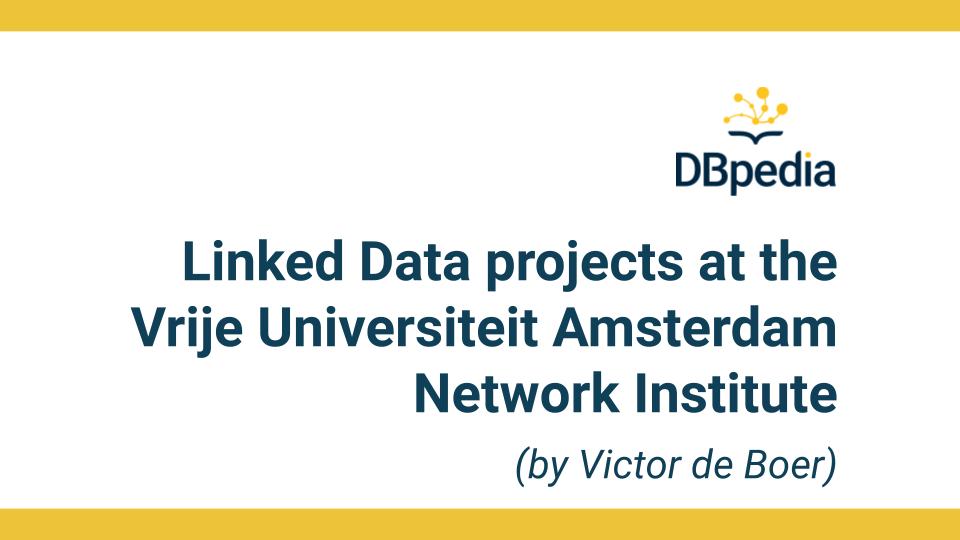DBpedia Member Features – Last year we gave DBpedia members the chance to present special products, tools and applications on the DBpedia blog. We have already published several posts in which our members provided unique insights. This week we will continue with the Network Institute (NI) of VU Amsterdam. They will introduce the NI Academy Assistants programme for bright young master students. Have fun while reading!
by Victor de Boer
The Network Institute of VU Amsterdam is an interdisciplinary and cross-faculty institute that studies the interaction between digital technology and society, in other words the Digital Society. Within the VU, it is a central player in realizing the VU’s Connected World research agenda. As such, the Network Institute supports the sharing of knowledge on the Web therefore is one of the partner members of DBpedia.
Network Institute Academy Assistant (NIAA)
Through a variety of activities, many VU researchers have benefited from their Network Institute-based collaborations, and the institute has introduced interdisciplinary research work to a generation of young VU scholars. One of the ways through which this is organized is through the NI Academy Assistants programme. With the Network Institute Academy Assistant (NIAA) program the Network Institute aims to interest bright young master students for conducting scientific research and pursuing an academic career. The program brings together scientists from different disciplines; every project combines methods & themes from informatics, social sciences and/or humanities. For each project, 2 or 3 student research assistants work together. Since 2010, several projects have included a Semantic Web or Linked Data component and several directly used or reflected on DBpedia information. We would like to showcase a selection here:
INVENiT
In the INVENiT project, which ran in 2014, researchers and students from VU’s computer science and history faculties collaborated on connecting the image database and metadata of the Rijksmuseum with bibliographical data of STCN – Short Title Catalogue of the Netherlands (1550-1800), thereby improving information retrieval for humanities researchers. As humanities researchers depend on the efficiency and effectiveness of the search functionality provided in various cultural heritage collections online (e.g. images, videos and textual material), such links drastically can improve their work. This project combined crowdsourcing, linked data and knowledge engineering with research into methodology.
Linked Art Provenance
One other example of a digital humanities project was the Linked Art Provenance project. The goal of this endeavour was to support art-historical provenance research, with methods that automatically integrate information from heterogeneous sources. Art provenance regards the changes in ownership over time of artworks, involving actors, events and places. It is an important source of information for researchers interested in the history of collections. In this project, the researchers collaborated on developing a provenance identification and processing workflow, which incorporated Linked Data principles. This workflow was validated in a case study around an auction (1804), during which the paintings from the former collection of Pieter Cornelis van Leyden (1732-1788) was dispersed.
Interoperable Linguistic Corpora
A more recent project was “Provenance-Aware Methods for the Interoperability of Linguistic Corpora”. The project addresses the interoperability between existing corpora with a case study on event annotated corpora and by creating a new, more interoperable representation of this data in the form of nanopublications. We demonstrate how linguistic annotations from separate corpora can be merged through a similar format to thereby make annotation content simultaneously accessible. The process for developing the nanopublications is described, and SPARQL queries are performed to extract interesting content from the new representations. The queries show that information of multiple corpora can now be retrieved more easily and effectively with the automated interoperability of the information of different corpora in a uniform data format.
Connected Knowledge
These are just three examples of a great many projects supported through the Network Institute Academy Assistants programme since 2010. A connected world needs connected knowledge and therefore we look forward to more collaboration with the Semantic Web and Linked Data community and DBpedia in specific.
A big thank you to the Network Institute, especially Victor de Boer for presenting their innovative programme.
Yours,
DBpedia Association
- Did you consider this information as helpful?
- Yep!Not quite ...

